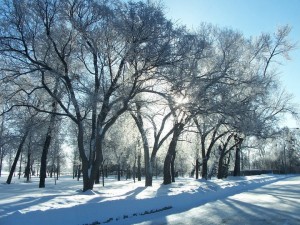I remember at the start of this semester I was asked to tell the class a little bit about myself, where I’m from and what I like about my hometown. I remember that I mentioned how much I missed the people back home, in Regina, Saskatchewan. It’s the feeling of being a part of a community the moment you arrive, a community that sticks with you wherever you go. I had never really given much thought to the physical layout of the city itself, but through our discussions in this course I’ve been realizing that it probably has much to do with the sense of community that has been created.
I’m writing my research paper on the development of Regina’s Wascana Park which is a pretty unique urban space. The construction of Wascana Lake (which now sits in the centre of the park) began in 1883 by damming the existing creek to create a functional watering hole for the eventual CPR. It very quickly became a site for recreational activities.
Another attempt to use the lake logistically, to cool machinery for the near by power plant, resulted in hot water being returned to the lake which pooled in a marsh area that remained unfrozen year round and over time developed into a bird sanctuary.
The old power plant is today the Saskatchewan Science Centre, the marsh is an official waterfowl sanctuary, and the park is also home to the provincial museum, provincial legislature building, art gallery, the university and other amenities. The park has earned the nickname of ‘the crown jewel of the Queen city’ and is loved and used year round by everyone.
Wascana Lake itself has also been a part of two urban revitalization projects. It was drained and deepened in the 1930s as part of a make work project and I remember the excitement surrounding the ‘big dig’ in the 2003-2004. The latest revitalization project involved making the lake bigger and deeper again, as well as improving water circulation by building a new waterfall island with the earth that was dug up. Regina then hosted the Canada Summer Games as well the Canadian Canoe Kayak National Championships.
I guess what I’m trying to sum up is that through my research I’m realizing just how much has gone into and come back out of this urban space in relation to community involvement. Any plan that was put forth for administrative or utilitarian reasons was eventually redirected by the actual community working on it. In recent history, the park is celebrated for being a community achievement and for its continued benefit and contribution to the city’s community.
It seems to me that Regina has successfully married the ideals of town and country and created a city that is thriving largely as a result of its community and its close relationship to urban planning.
I guess my views of my hometown are similar to what they initially were at the beginning of this course in that it is the people, and sense of community, that I miss most. I have changed my views in learning how this sense of community was created through the history of urban planning. Has anyone else reflected on their hometown since this course? Have your views or opinions changed at all?


The description of how urban planning turned what was once a utilitarian commercial asset into a collective amenity for Regina’s city residents and how this has fostered a sense of community provides a ready example of how urban planning can succeed. Through our examination of planners in this course (perhaps most strikingly Le Corbusier and his Athens Charter) we have seen how urban planning has failed when it fails to account for the actual desires and needs of residents. Through the participation of community, as demonstrated by the transformation of Wascana Park it is clear that urban planning can succeed in creating livable spaces in communities.